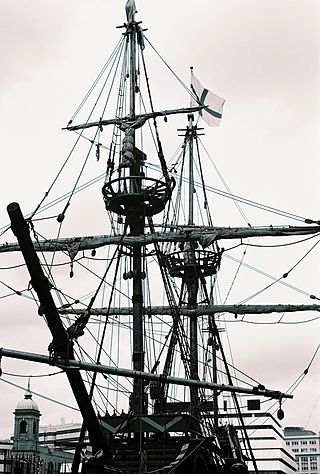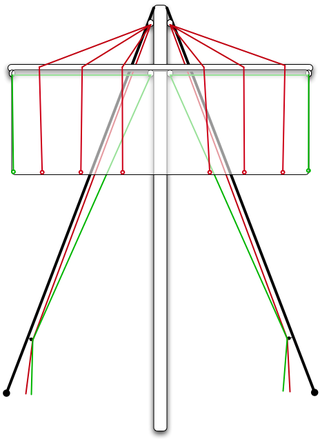
Rigging comprises the system of ropes, cables and chains, which support and control a sailing ship or sail boat's masts and sails. Standing rigging is the fixed rigging that supports masts including shrouds and stays. Running rigging is rigging which adjusts the position of the vessel's sails and spars including halyards, braces, sheets and vangs.

A sailing ship is a sea-going vessel that uses sails mounted on masts to harness the power of wind and propel the vessel. There is a variety of sail plans that propel sailing ships, employing square-rigged or fore-and-aft sails. Some ships carry square sails on each mast—the brig and full-rigged ship, said to be "ship-rigged" when there are three or more masts. Others carry only fore-and-aft sails on each mast, for instance some schooners. Still others employ a combination of square and fore-and-aft sails, including the barque, barquentine, and brigantine.

A sailing vessel's rig is its arrangement of masts, sails and rigging. Examples include a schooner rig, cutter rig, junk rig, etc. A rig may be broadly categorized as "fore-and-aft", "square", or a combination of both. Within the fore-and-aft category there is a variety of triangular and quadrilateral sail shapes. Spars or battens may be used to help shape a given kind of sail. Each rig may be described with a sail plan—formally, a drawing of a vessel, viewed from the side.

In sailing, a halyard or halliard is a line (rope) that is used to hoist a ladder, sail, flag or yard. The term "halyard" derives from the Middle English halier, with the last syllable altered by association with the English unit of measure "yard". Halyards, like most other parts of the running rigging, were classically made of natural fibre like manila or hemp.

A traveller is a part of the rigging of a boat or ship that provides a moving attachment point for a rope, sail or yard to a fixed part of the vessel. It may take the form of anything from a simple ring on a metal bar or a spar to, especially in a modern yacht, a more complex "car" – a component with bearing-mounted wheels running on a shaped aluminium extrusion.

Boat building is the design and construction of boats — and their on-board systems. This includes at minimum the construction of a hull, with any necessary propulsion, mechanical, navigation, safety and other service systems as the craft requires.

A maritime flag is a flag designated for use on ships, boats, and other watercraft. Naval flags are considered important at sea and the rules and regulations for the flying of flags are strictly enforced. The flag flown is related to the country of registration: so much so that the word "flag" is often used symbolically as a metonym for "country of registration".

Running rigging is the rigging of a sailing vessel that is used for raising, lowering, shaping and controlling the sails on a sailing vessel—as opposed to the standing rigging, which supports the mast and bowsprit. Running rigging varies between vessels that are rigged fore and aft and those that are square-rigged.

A yard is a spar on a mast from which sails are set. It may be constructed of timber or steel or from more modern materials such as aluminium or carbon fibre. Although some types of fore and aft rigs have yards, the term is usually used to describe the horizontal spars used on square rigged sails. In addition, for some decades after square sails were generally dispensed with, some yards were retained for deploying wireless (radio) aerials and signal flags.
This glossary of nautical terms is an alphabetical listing of terms and expressions connected with ships, shipping, seamanship and navigation on water. Some remain current, while many date from the 17th to 19th centuries. The word nautical derives from the Latin nauticus, from Greek nautikos, from nautēs: "sailor", from naus: "ship".

In sailing, a sheet is a line used to control the movable corner(s) (clews) of a sail.

In sailing, a boom is a spar (pole), along the of a fore and aft rigged sail, that greatly improves control of the angle and shape of the sail. The primary action of the boom is to keep the foot flatter when the sail angle is away from the centerline of the boat. The boom also serves as an attachment point for more sophisticated control lines. Because of the improved sail control it is rare to find a non-headsail without a boom, but lateen sails, for instance, are loose-footed. In some modern applications, the sail is rolled up into the boom for storage or reefing.

Blackadder was a clipper, a sister ship to Hallowe'en, built in 1870 by Maudslay, Sons & Field at Greenwich for Jock Willis & Sons.

Each yard on a square or gaff rigged sailing ship is equipped with a footrope for sailors to stand on while setting or stowing the sails.

Clewlines and buntlines are lines used to handle the sails of a square rigged ship.

The junk rig, also known as the Chinese lugsail, Chinese balanced lug sail, or sampan rig, is a type of sail rig in which rigid members, called battens, span the full width of the sail and extend the sail forward of the mast. While relatively uncommon in use among modern production sailboats, the rig's advantages of easier use and lower maintenance for blue-water cruisers have been explored by individuals such as trans-Atlantic racer Herbert "Blondie" Hasler and author Annie Hill.

James Baines was a passenger clipper ship completely constructed of timber in the 1850s and launched on 25 July 1854 from the East Boston shipyard of the famous ship builder Donald McKay in the United States for the Black Ball Line of James Baines & Co., Liverpool. The clipper was one of the few known larger sailing ships rigged with a moonsail.

Potosi was a five-masted steel barque built in 1865 by Joh. C. Tecklenborg ship yard in Geestemünde, Germany, for the sailing ship company F. Laeisz as a trading vessel. Its primary purpose was as a "nitrate clipper" collecting guano in South America for use in chemical companies in Germany. As its shipping route was between Germany, Bolivia until 1870 but, during the "pacific War" was transferred to Chile, it was designed to be capable of withstanding the rough weather encountered around Cape Horn.
The following outline is provided as an overview of and topical guide to sailing:
This glossary of nautical terms is an alphabetical listing of terms and expressions connected with ships, shipping, seamanship and navigation on water. Some remain current, while many date from the 17th to 19th centuries. The word nautical derives from the Latin nauticus, from Greek nautikos, from nautēs: "sailor", from naus: "ship".




















